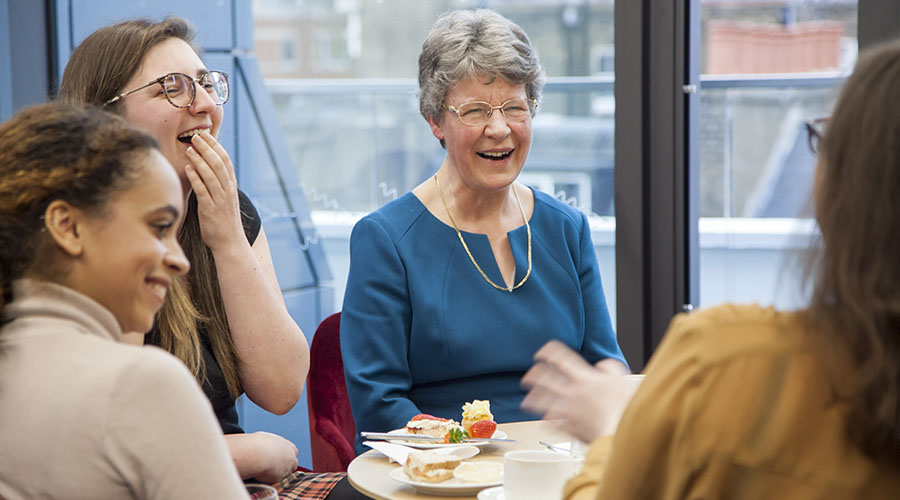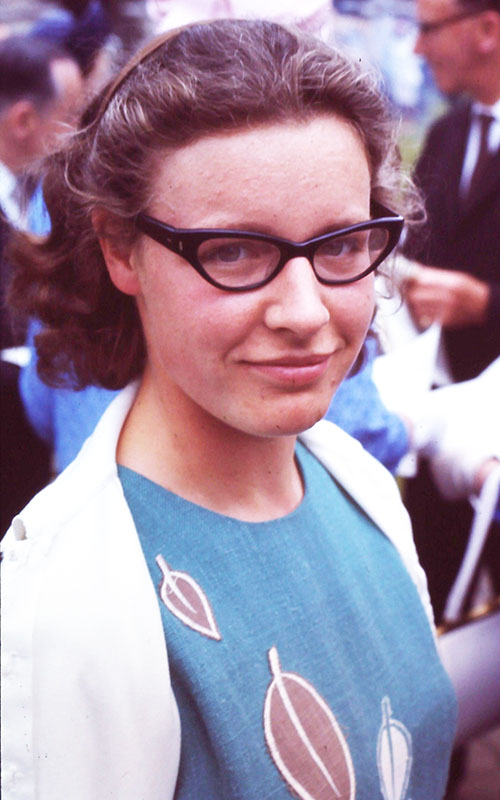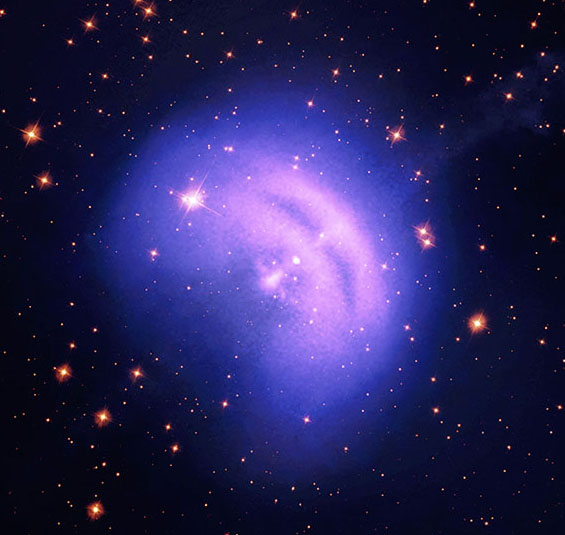
March 2024 (Volume 33, Number 2)
Jocelyn Bell Burnell, Whose 1967 Discovery of Pulsars Landed Her Supervisor a Nobel, Tells Young Physicists, “Don’t Second-Guess Yourself”
CUWiP’s 2024 keynote speaker addressed thousands of attendees across the U.S.
By Liz Boatman | February 16, 2024

Credit: Carl Bigmore / Institute of Physics
Jocelyn Bell Burnell (center).
On a physics exam in the early 1960s, a student read a simple question: What’s the speed of light? She wrote the correct answer, 186,000 miles per second, but then paused. That seemed so fast. Too fast. Doubt crept in. She erased “second” and wrote “hour,” which dropped her score — to 97%.
That student was Jocelyn Bell Burnell. Only a few years later, in 1967, she discovered pulsars — a feat that helped earn her doctoral advisor, Anthony Hewish, the 1974 Nobel Prize in Physics. While Bell Burnell didn’t win a Nobel, she has since won other science honors, including the 2018 Breakthrough Prize (she gave the $3 million in prize money to a doctoral scholarship fund for women and people from other underrepresented groups in physics).
Bell Burnell, the keynote speaker for APS’s 2024 Conferences for Undergraduate Women in Physics (CuWiP), recounted the story of her first exam error to thousands of young women and gender-diverse attendees. The talk was streamed live across 14 CuWiP host sites throughout the United States on Saturday, Jan. 20.
“You’re often right the first time, so don’t second-guess yourself,” she said — a lesson that’s especially important for women in a field still dominated by men.
When Bell Burnell graduated with her bachelor’s from the University of Glasgow and headed to Cambridge for her doctorate in 1965, Cambridge “was full of young men who were very full of themselves,” she said. She worked her “very, very hardest” to prove she deserved to be there, too.
Just two years earlier, astronomers had discovered the first quasar, an extremely bright galactic core with a supermassive black hole at its center. By 1965, only about 20 quasars had been identified. Bell Burnell spent the next two years helping build a gigantic radio telescope that could detect more of them. “And we did,” she said. “We found a lot more.”
Covering a four-acre patch of countryside, the radio telescope relied on 120 miles of wire and cable to receive incoming radio signals. A strip chart recorder captured those signals on long spools of paper, in printouts that looked similar to a lie detector’s. Energetic, high-frequency pen lines could be indicators of a strong radio signal, like that from a quasar.
The telescope spat out 100 feet of chart paper per day. From miles of paper, Bell Burnell went on to discover more than 200 quasars in a few years.
But one day in November 1967, she noticed an unusual signal, dozens of lines scrunched into one-quarter of an inch on a 400-foot spool. The pattern looked like a blip of electrical interference, except at much higher frequency.
Near it, she scribbled a question mark.
As the days passed and the paper piled up, Bell Burnell kept wondering about that question mark. “I’m left puzzled by that signal … and then I see it again, from the same bit of sky,” she recalled thinking. Her advisor, Hewish, suggested she feed the paper faster, to stretch the signal out and make it more visible.
Bell Burnell measured the period of the object’s signal at about 1.3 seconds. Again, not just fast — too fast. Hewish worried that Bell Burnell had set up the equipment wrong. He called a colleague with access to a second radio telescope.
When that telescope picked up the same rapid pulses, Bell Burnell and Hewish knew for certain: The signal was real, and it was coming from “something up there amongst the stars.”
“But we’d come to recognize quite a serious problem,” she said. Their analysis revealed the object was 200 light-years away, and tiny. Stranger still, the signal’s intensity never wavered. For its signal to travel so far and remain so strong, the source would have to be producing an incredibly high-intensity radio signal.

Credit: Roger W. Haworth (Flickr, CC BY-SA 2.0 DEED)
Jocelyn Bell in June 1967, a few months before her pulsar discovery.
Then Bell Burnell found another cluster of rapid pulses elsewhere in the sky — a second object with a similar signal. By early 1968, the duo had enough data to publish a paper in Nature, which attracted a media frenzy. Unhappy with the wordy label “pulsating radio star,” the press landed on “pulsar” instead. Scientists now know that pulsars are dense, rotating neutron stars that shoot radiation from their magnetic poles.
In the years since, Bell Burnell says many have approached her at conferences or written to her to recount moments when they “nearly discovered pulsars” but second-guessed themselves, or weren’t believed. “These stories are interesting,” she said, “because they say a lot about how science works.”
For example, about a decade before Bell Burnell’s discovery, in 1957, one young woman was viewing the crab nebula through a research telescope that was open to the public one night per month. She told the observatory assistant that one of the stars was flashing.
The assistant couldn’t see it, and he dismissed her comment. We now know there’s a pulsar in the crab nebula that flashes at 30 Hz, said Bell Burnell, a flicker rate that’s too fast for most people — but not all people — to see. “I think she saw it,” Bell Burnell said.
Bell Burnell finished her talk by listing the circumstances that she believes led to her discovery of pulsars in 1967. Chief among them was having the time and space as a graduate student to dig into anomalies with painstaking thoroughness — a thoroughness borne partially, she noted, from “imposter syndrome,” from so many years of being the only woman in the room. To combat self-doubt, she tackled her work with intense attention to detail.

Credit: NASA/CXC/SAO (Chandra), NASA/MSFC/F. Xie et al. (IXPE); Optical: NASA/ESA/STScI; Image processing: NASA/CXC/SAO/J. Schmidt, K. Arcand
A composite image showing the Vela Pulsar, one of the brightest pulsars.
So, what about that moment in 1967 when Hewish suggested Bell Burnell had set up her equipment wrong? She told the audience that, as a grad student, she knew her instrument and data inside and out. The young Bell Burnell knew, without a doubt, that the curious cluster of signals in her miles of spooled paper were real.
Liz Boatman is a science writer based in Minnesota.
©1995 - 2024, AMERICAN PHYSICAL SOCIETY
APS encourages the redistribution of the materials included in this newspaper provided that attribution to the source is noted and the materials are not truncated or changed.
Editor: Taryn MacKinney
March 2024 (Volume 33, Number 2)
Articles in this Issue
